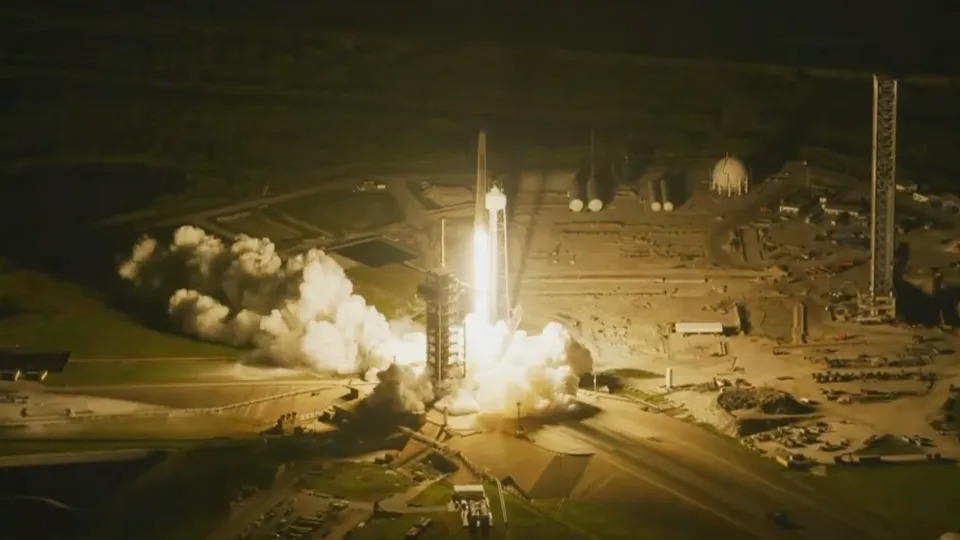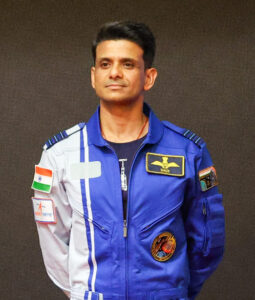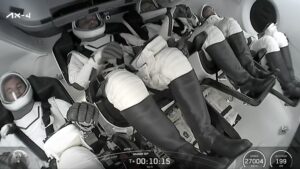It is fascinating to know that the astronauts would have no clue about what is happening to their vehicle or the atmosphere outside the capsule except through those numbers and images on the computers.
Published Jun 25, 2025 | 7:07 PM ⚊ Updated Jun 25, 2025 | 7:09 PM

The mission lifts off from Launch Complex 39A at NASA’s Kennedy Space Center.
Synopsis: The lesson is clear – sometimes you may get the technology right, sometimes you may not. Which means the conclusion is that despite all of humankind’s expertise with technology is never perfect. Expertise apart, space flight is also about chance and luck.
SpaceX’s Starship rockets suffered four failures in 2025, one after the other. The most recent one was on 18 June, seven days before Wednesday’s (25 June) Axiom Mission 4 Launch on SpaceX’s Falcon 9 rocket, carrying Indian astronaut Group Captain Shubhanshu Shukla and three others to the International Space Station (ISS).
The Axiom mission itself was deferred six times for technical and weather considerations before liftoff. The implications and lessons of this are clear: Technology and the creation of technology by humans are fraught with risk. It can sometimes be perfect and not so at other times, which means there is always the element of uncertainty. More because the actions we undertake to craft technology seem to leave room for error, as evidenced by the Starship failures of a company, perhaps the numero uno in space endeavors following NASA.
It has to be acknowledged that despite a miserable journey with SpaceX’s Starship rockets in the last six months, the Falcon 9, the company’s other flagship rocket, has a rigorous and far better safety record despite a few failures. Rockets from the Falcon 9 family have a success rate of 99.4% and have been launched 503 times over 15 years, resulting in 500 full successes.
There have only been two in-flight failures (SpaceX CRS-7 and Starlink Group 9–3), one pre-flight failure (AMOS-6 while being prepared for an on-pad static fire test), and one partial failure of its class, which is four in about 15 years.
Interestingly, despite its higher rate of success, SpaceX plans to deploy Starship rockets as the successor to its Falcon models to conduct missions to the moon, and eventually, Mars. It could be asked whether Falcon 9 itself could have been modified to undertake these missions. But the class of rockets is different, and the time and money required are considerations.

Group Captain Shubhanshu Shukla. (Wikimedia Commons)
The 18 June explosion of the Starship rocket at Starbase, Texas, was reminiscent of the sudden failure of a SpaceX Falcon 9 rocket during fueling at Cape Canaveral in August 2016 that destroyed an Israeli communications satellite. The Falcon 9 failure was blamed on the rupture of a high-pressure helium tank, known as a composite overwrapped pressure vessel, or COPV. Since then, matters have been set right, and Wednesday’s Falcon 9 flight to the ISS at the time of takeoff was flawless.
The Falcon 9 is remarkable as the world’s first orbital-class reusable rocket. Reusability has been in the making for a while, but when work began on it, its operationalisation occurred fast. The world watched Falcon 9 rocket’s first booster stage landing back onto the Florida pad perfectly after separation mid-air, a few minutes into its flight to the ISS.
Falcon 9 is a reusable, two-stage rocket designed and manufactured by SpaceX for the reliable and safe transport of people and payloads into the Earth’s orbit and beyond. NASA certified the Falcon 9 for human spaceflight in November 2020, making it the first commercial spacecraft system approved for regular human flights since the space shuttle in 1981.
Interestingly, NASA’s space shuttle has been an epitome of perfection in the journey to space and ISS, but as human history has always shown, some mistake somewhere can prove costly – the Kalpana Chawla story is evidence.

Group Captain Shubhanshu Shukla is serving as the mission’s pilot. (X)
Kalpana was the first Indian-American astronaut and the first woman of Indian origin in space. She first flew on Space Shuttle Columbia in 1997 as a mission specialist and primary robotic arm operator, and this was a perfect flight. But who was to anticipate that the same Space Shuttle, Columbia, would, six years later, in 2003, disintegrate while re-entering the Earth’s atmosphere? Everything with the space shuttle was alright till then.
Later investigations revealed an error in judgment that went into the making of some materials that resulted in the loss. The material was not strong enough, and the decision to deploy that material was also wrong.
Following NASA’s history, SpaceX learnt to embrace its failures, using data collected from explosions and missteps to improve its products, and thus can be seen in its consistency in safe flights of the Falcon 9.
Shubhanshu’s liftoff was heartening and evidence that the experts have got their act right. Several minutes into the flight, the rocket’s stages began separation, and the astronauts began experiencing micro-gravity, moving from 1G to 3G. You could see them calm inside the Dragon 3 space capsule, sitting silently next to each other, and watching and moving with their fingers on the touch-screens of the mission computers.
It is fascinating to know that the astronauts would have no clue about what is happening to their vehicle or the atmosphere outside the capsule except through those numbers and images on the computers. If the computers fail, there are manual backups.
Sitting inside the capsule looks simple, but it’s about how much your body and brain, and mind can take (no wonder, to handle micro-gravity and its rush of blood, Shubhanshu and his companions had to experience rigorous scientific training for over two years in Russia, the US, Europe, and India). This is not easy. The physical and mental stamina required can sometimes break the common man.
The journey will take 28-and-a-half hours, and the rocket will dock at 7 am at the ISS on Thursday, 26 June, signaling that India has renewed its human space flight 40 years after Wing Commander Rakesh Sharma first did so on a Soviet rocket to space.
The ISS orbits Earth at an average altitude of approximately 400 kilometers (about 250 miles). While this distance may seem small, it takes varying amounts of time for spacecraft to reach the ISS since it has to achieve the correct orbit and perform rendezvous maneuvers.
In the 14 days that Shubhanshu and his companions from Poland, Hungary, and the US would stay at the ISS, they would carry out studies and research that are expected to benefit future human journeys to what will be private, commercial space stations in the wake of the decommissioning of the ISS by 2030.
The assessment is that Shubhanshu’s experiences would impart key learnings for India’s human space flights on its rockets in around two years. The know-how and success coming out of India’s human space flight endeavor would cement and establish the country’s space capabilities, which only about five countries in the world now possess. We are very close to that elite status, even if we are taking time to get there.
Shubhanshu is reaching space 64 years after Yuri Gagarin, the Soviet cosmonaut, first did, on April 12, 1961, aboard the Vostok 1 spacecraft. Here’s wishing a safe return to Shubhanshu and his companions.
(P Ramanujam is a Science, Space, and Technology Commentator. Views are personal. Edited by Majnu Babu).
